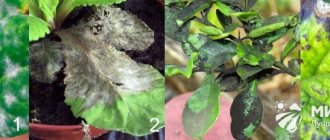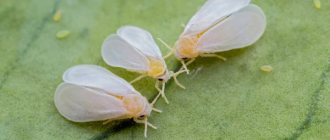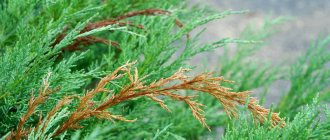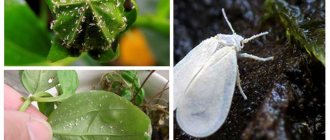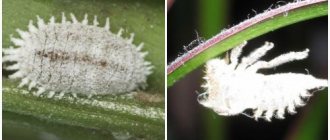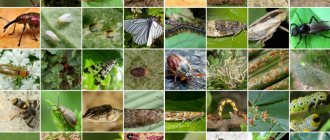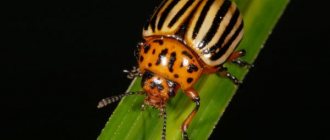Symptoms to recognize harmful insects
What needs to be done to save pets? First of all, find out what harmful insects have infested the flowers. To do this, a thorough examination of the plant itself and the soil is carried out. After this, they begin a merciless fight using various methods. Remember, any delay is fraught with disastrous consequences.
Insects live in the soil (on roots), on leaves, stems, and gnaw buds.
Pests of indoor plants
| in the soil (in the ground) | on the green parts of the flower |
| root mealybug | mealybug |
| enchytrea | whitefly |
| root-knot nematodes (larvae) | spider and clover mite |
| fungus gnats | scale insect |
| white idiot | aphid |
| cyclamen mite |
Plants react to each pest in a special way: they can change the color of leaves and slow down their growth. When visually examining a houseplant, you can notice changes in the leaves and stems.
Appearance of white spots
White spots are a signal of the appearance of:
- Mealybug or rootbug. You need to examine all parts of the flower. If you notice “cotton” lumps, it means there is a pest.
- When whiteflies appear, the leaves become sticky and may fall off.
- The presence of a red spider (clover) mite can be determined by the whitish mesh, spider mite by the cobweb. Leaves with a large number of insects die off.
What do yellow spots signal?
If yellow spots appear on the leaves, you need to inspect the leaves. If fingers stick to them, these are marks left by scale insects. The cause may be the appearance of enchytraea. Tiny white worms live in the soil right at the root.
Brown spots
The presence of brown, brownish spots on the bottom of the leaf and white streaks on top indicates the action of thrips.
Deformation of green parts of the plant
If the shoots and leaves on the flowers begin to deform, it means that the flower is affected by aphids or cyclamin mites. Aphids leave behind sticky residues. It sucks the juice from indoor plants, which can cause them to dry out. If dust appears on the leaves below, they curl—the mite is in control.
Withering
The cause of drooping leaves and shoots is fungus gnats, leaf or root-knot nematodes.
Shields
It is not difficult to recognize the scale insect: on the leaves and stems it looks like a tubercle or compaction. The insect attaches itself to the plant, making its stems and leaves sticky (Figure 2).
Scale insects feed on sap, causing the flowers to gradually weaken. As a rule, the presence of insects is determined before the crop dies, and therapeutic measures are taken in time.
You will find more information about this type of insect and how to combat it in the video.
Ways to fight
To combat scale insects, systemic insecticides Confidor, Aktara and Mospilan are used. These products are effective against all insects except ticks. To get the desired effect, you need not only to spray the leaves, but also to water the soil with the prepared solution so that the drug is absorbed by the roots.
Figure 2. Damage to flowers by scale insects
If the infestation is minor, you can also eliminate scale insects manually: collecting insects and wiping the stems with a damp, clean cloth. After this, it is necessary to carry out preventive spraying with Karate or Actellik, and all new specimens must be quarantined.
Description of pests
Pests of indoor plants can cause harm and lead to the death of green spaces if they are not dealt with. Let's look at the most common insects and their destructive activities.
Spider mite
Spider mites are the most common “guest” on indoor plants. Due to their small size, they cannot be seen with the naked eye. You need to examine the lower part of the flower, because these pests do not tolerate light and moisture. Insects may appear in a dry and hot room. In such conditions, the development of spider mites is rapid.
If you have geraniums, hibiscus, palm trees, aspidistra, then they need to be inspected constantly. Insects pierce the tender part of the leaves and suck out the juice. As a result, the leaves become faded and crumble.
Aphid
Aphids can be seen despite their small size. They come in black and green. Insect colonies multiply rapidly: the female lays at least 150 larvae, which after 7 days themselves enter the reproduction stage. Females of the third generation have the ability to fly. They move onto any indoor plants and lay larvae. Diseases are transferred to flowers on their paws, for example, different types of flower mosaics. Getting rid of aphids is not as easy as it seems.
Shields
Scale insects on indoor plants are a dangerous pest; they love to settle on cuttings, leaves, and stems. It is not difficult to detect: it is flat, oval, with the lower part of its body tightly adjacent to the substrate.
These pests are different. Real scale insects hide under their shells, just like turtles. False scale insects do not have this possibility, since this part of the body is inseparable.
The favorite colors of these pests are:
- lemons;
- oranges;
- tangerines;
- asparagus;
- oleanders;
- ivies;
- palm trees
Scale insects settle on the lower part of the leaf. Colonies develop quickly. Slowly moving dots appear on the leaves, somewhat reminiscent of plaques. The leaves around their habitat turn yellow. Insects suck out the juice of tender plants and shoots, depleting the plant. If you do not start a timely fight, indoor flowers die.
Thrips
Ficus, begonias, dracaenas, and palm trees are affected by a small jumping beetle - thrips. The females make holes in the leaves or flower buds and lay eggs. The damage is microscopic and impossible to notice with the naked eye. A signal that thrips are on indoor plants is a silvery pattern appearing on the leaves. The insects themselves live on the back side of the leaf.
White Podura
These creatures can also jump. This is a soil insect that lives directly in pots. It is distinguished by an elongated body, on which sparse hairs are visible. There are antennae on the head. Most often they appear in soils rich in humus.
The basis of nutrition is plant residues, but it does not disdain the living root system. It is clear that the eaten roots can no longer cope with their function, the plant slows down its growth and may die.
Mealybugs
These are white worms; they love the back of the leaf in the places where the vein runs. Females are large, up to half a centimeter, very fertile. They build houses for their offspring that look like balls of cotton wool, and lay eggs in them. The hatched larvae are mobile and quickly conquer space on the flowers. Gardeners who grow azaleas and cacti need to constantly inspect their plants for signs of mealybugs. These pests of indoor plants prefer them and it is necessary to take immediate measures to combat them.
Whitefly
Whiteflies are, by and large, greenhouse insects. If you purchased flowers in these places, do not be lazy to examine them carefully. Even one female whitefly on indoor plants will produce huge offspring in a short time. Then the question will arise of how to fight. The pest's favorite flowers are fuchsias, ferns, and geraniums. The two-millimeter insect feeds on plant sap, and as a result it weakens and withers.
Fungus gnats
It often happens that flower growers notice small flies flying around their flowers, but do not attach any importance to it. And in vain, because the fly lays larvae in moist, fertile soil. The larvae are microscopic, so their appearance is not immediately noticeable. The danger of insects is that the smallest creatures feed on the root system of plants. As a result, the flower dies.
Mealybug
It is very easy to identify the lesion by the characteristic white formations, similar to cotton wool or clumps of white cobwebs. Most often it affects cacti, spreading through their root system (Figure 3).
Figure 3. Mealybug Symptoms
For control, the drugs Confidor and Aktara are used, using the solution not only for spraying, but also for watering the soil.
How to control pests on indoor plants
Many novice gardeners are wondering how to deal with pests of indoor plants. The answer to this is important, since insects multiply rapidly, time must not be wasted.
There are different ways to help get rid of pests:
- mechanical;
- biological;
- folk;
- chemical.
If pests of indoor plants are correctly identified, and measures to combat them will be effective.
Mechanical
You need to start with the measures that are safest for humans, especially since they often help a lot. Before starting work, you should disinfect and sharpen your tools. All damaged leaves and shoots are cut off, and the cut areas should be sprinkled with activated carbon. Bugs and visible larvae are selected manually: scale insects, slugs, caterpillars. Leaves with pests such as aphids can be wiped with a cotton pad. A contrast shower and spraying with water helps get rid of pests living on the green parts of the plant.
Biological
How to fight harmful insects with biological means? Such preparations are created based on plants. Most often used:
- "Fitoverm";
- "Agrovertin";
- "Iskra-Bio".
Before use, you should read the instructions. Since they destroy pests, they contain poison in small doses. The plants are treated early in the morning and left in a shaded place until all parts of the plant are dry. The room where the treatment was carried out is ventilated. You need to wash all exposed parts of the body with warm water and detergent.
Traditional methods
If indoor plant pests appear, treatment can be carried out with time-tested folk remedies. For this, decoctions and infusions are prepared from:
- yarrow;
- chamomile;
- dandelion;
- marigolds;
- nettle;
- garlic;
- Luke;
- peels of oranges, tangerines, lemons.
These environmentally friendly and harmless plants can effectively destroy harmful insects. Steamed citrus peels can be buried in the soil. Insects don't like their smell.
An infusion of tobacco, stove ash, a solution of potassium permanganate, furatsilin or soda works well. To prevent the liquid from immediately draining from the plants, laundry soap is added to it.
Chemical
When using chemical pest control products, rapid success can be achieved. It is better to resort to their help as a last resort if other methods have not given a positive result. It should be remembered that such products are unsafe for humans and beneficial insects. You need to work with chemicals with the window open, removing children and animals from the room. In addition, when working you need to use personal protective equipment. After work, you need to thoroughly wash your hands and face. The treated plants are placed in the shade until the solution is completely dry. The area where the treatment was carried out must be washed with hot water and detergents. Remember that chemicals are toxic, therefore, they should be stored in places inaccessible to children and pets. Popular and effective remedies for pests of indoor plants:
- "Karbofos";
- "Chlorophos";
- "Syphos";
- "Trichlorometaphos";
- "Pyrethrum";
- "Decis";
- "Fury."
They are capable of destroying almost all harmful insects.
Aphid
Small insects that settle in entire colonies on crops in open ground and in city apartment conditions. The aphid sticks to the stems and drinks juice from them (Figure 6).
Figure 6. Aphids on plant leaves
Since insects reproduce very quickly, they are capable of destroying all plants in a short time. Therefore, when the first signs of damage are detected, the flower must be treated with the systemic insecticide Aktara or contact Decis and Karate.
How to spray water for spraying
The quality of spraying depends on the size of the sprayed droplets. A simple sprayer that supplies water by pressing the handle of a hand pump has several modes of operation, but the particles of water that fly out of the holes are quite large and uneven. More modern models allow you to create a fine mist that lingers in the air much longer. When it gets on the leaves, its drops are quickly absorbed, and the residues easily evaporate without causing increased humidity on the shoots of plants.
It should be taken into account that when caring for indoor flowers, both spraying methods are used:
- A fine spray of water in the form of a mist is suitable for daily increasing the air humidity around the bush.
- Spraying larger drops is required for foliar feeding with fertilizer solutions and removing dirt and dust from the surface of leaves.
Prevention
To avoid the question of how to get rid of midges from indoor flowers, you need to follow simple rules.
Fallen, crumpled leaves and inflorescences should be removed in a timely manner, thereby keeping the soil clean. Rotting plant debris in the ground creates ideal conditions for insects to live. Proper watering guarantees the absence of insects in flower pots
It is important not to waterlog the soil, allowing it to dry out. You should not use tea leaves and similar organic matter as a top dressing. To prevent indoor midges from infesting flower soil, it should be steamed or frozen before use. The flowerpot itself must also be disinfected with boiling water or a manganese solution. Don't forget to loosen the soil regularly
This way it dries out better and is enriched with oxygen. To prevent the reproduction of midges in a flower pot, sprinkle the surface of the soil with coarse sand or marble chips. This will limit the ability of insects to lay eggs in the soil. Having discovered midges in a plant, it is necessary to treat all home plantings for preventive purposes, since in the early stages of infection it is not always possible to distinguish the affected specimen.
By following these simple rules, the question of what to do if you have midges will not arise. And flowers will respond to your love and care with beautiful blooms and lush growth.
Shag tobacco and ash
Tobacco and ash are used to remove gnawing and sucking insects: aphids, mites, thrips, beetles, caterpillars, worms, etc. They also get rid of flower midges. But pure tobacco is suitable for plants, without impurities and flavorings, preferably as strong as possible! Moreover, fresh raw materials will also work – tobacco leaves, or shag leaves, and even tobacco dust. An infusion is made on them: pour hot water (at the rate of 1:10) and leave for a day. The finished solution is diluted with water 2 times, for greater viscosity, laundry soap is added - 40 g. for 10 l. The resulting mixture is thoroughly sprayed onto the plants.
A similar recipe works for wood ash. However, it is worth considering that the raw materials for medicinal ash should be exclusively clean materials - paper, wood. You can lightly sprinkle the soil of potted flowers with dry tobacco and ash. This folk remedy for plant protection repels insects, including midges. Among other things, ash is a valuable fertilizer; the flowery-blog.ru website talked about its use in this article.
Which plants need spraying?
Cyperus, guzmania and palm trees are plants that require regular spraying
Most houseplants benefit from misting.
They are especially important for species with dense, leathery or large, rosette-forming leaves. Such indoor flowers evaporate a lot of moisture and need high air humidity, especially in the summer or heating season at temperatures above 20°C.
Regular spraying is necessary:
- tropical plants, for example, calathea, aglaonema, anthurium, orchid;
- coniferous species, in particular cypress and araucaria;
- citrus fruits - lemon, tangerine, grapefruit;
- plants with delicate flowers, for example azaleas, brunfelsia, anthurium, gardenia, but it is advisable to protect the petals from water;
- ferns, ficus;
- bromeliads - Aechmea, Nidularium, Neoregelia, which under natural conditions absorb water that falls into funnels from the leaves during rain.
What are insecticides?
Insecticides are chemical or biological agents that kill insect pests. Biological agents are not so dangerous. Before using any insecticide, you need to test it on one plant. If after 24 hours the condition of the flower has not worsened, then you can use the product on all plants of this variety. To prevent plants from becoming addicted, it is recommended to alternate insecticides for indoor plants.
Treat all plants, being sure to follow safety precautions. It is necessary to wear at least a respirator when using insecticides, since the drug is very quickly absorbed into the blood through the lungs. Read the instructions carefully and follow them when using the drug.
Rotten
Rot often develops from excess moisture in low temperature conditions.
There are several types of rot.
Gray
Gray mold is caused by the fungus Botrytis cinerea Pers and infects areas of the plant that are dying. If conditions are created that are favorable for the development of rot, then a healthy plant may also be affected. Most often, crops with succulent foliage, such as begonia, Saintpaulia, gloxinia, etc., suffer from gray rot.
Its first signs: there is a loss of elasticity of the leaves, they become wilted and change their natural color. Brown spots of various shapes appear on them. Then the flowers and leaves become covered with light gray mold, become softened and subsequently die. When watering or spraying, spores from diseased plants can fall on healthy ones and infect them. Therefore, as a preventive measure, it is not recommended to place plants very closely together; it is necessary to frequently ventilate the room with plants and, if possible, prevent water from penetrating the foliage and flowers when watering.
The fight against gray mold includes:
- destroying all infected leaves, stems or flowers;
- organizing good lighting and thinning crops;
- treatment with topsin-M (0.1%), foundationazole (0.2%), a mixture of copper sulfate and soap. After 10 days, the plants must be re-treated.
White
White rot is caused by the fungus Sclerotinia sclerotiorum, which can affect different types of houseplants. White rot is expressed as rotting at the bottom of the stem and wilting at the top. At the bottom, the leaves become discolored and fill with water. Sometimes a ball of white plaque appears on them. If you cut the stem, you can see the sclerotia of the black fungus. In some cases they are visible on top of the stem. A sharp manifestation of the disease can occur with temperature changes or 12–15 degrees (subject to high humidity).
The diseased plant is removed along with the soil in which it grew.
Stem rot can occur under the influence of several factors:
careless division of the crop during transplantation; damage to roots by pests; abundant watering after excessive drying, as a result of which the root partially dies, and putrefactive organisms seep into the wounds; excessive fat content of soil mixtures.
Since the fungus parasitizes very quickly, you can try to save the plant only at the beginning of the disease by removing the affected areas. When the form is neglected, the flower is removed along with the soil.
Root rot
Root rot occurs in the root collar and eventually spreads to the entire root. The most
wounded plants that suffer from this serious disease are begonia, saintpaulia, dieffenbachia, cyclamen, palm. If there is root rot, then the leaves of the plants very quickly turn yellow and wither, soon become dark and die.
At an early stage, you can try to save the culture. It is necessary to remove it from the pot, rinse it and inspect the roots. Trim off rotten areas and the tops of stems. Then plant it in a new pot, changing the soil and watering it with carbendazim solution. Place the pot in a well-lit place, but without direct sunlight. Do not water until a new shoot has sprouted. Then watering must be carried out without allowing waterlogging.
https://youtube.com/watch?v=XamR5viTpb0
Ways to combat Colorado potato beetles
Mixtures prepared independently are aimed at repelling adult insects. Treatment is carried out before the appearance of beetles and during their summer.
Walnut leaves
Dry leaves (2 - 3 kg), add 10 liters of water, infuse for 3 - 5 days.
Birch tar
Dilute a 100 ml bottle of tar in a bucket of water. Spray potato tops every 2 - 3 days. You can use tar soap - 100 g bar.
Multicomponent mixture
Pour all ingredients into a bucket of water and bring to a boil. After 12 hours you can use it by thoroughly watering the leaves.
Compound:
- wormwood - 0.3 kg;
- hot pepper (powder) - 1.5 tablespoons;
- garlic - 0.2 kg;
- soap - 50 g;
- hemlock - 0.2 kg


